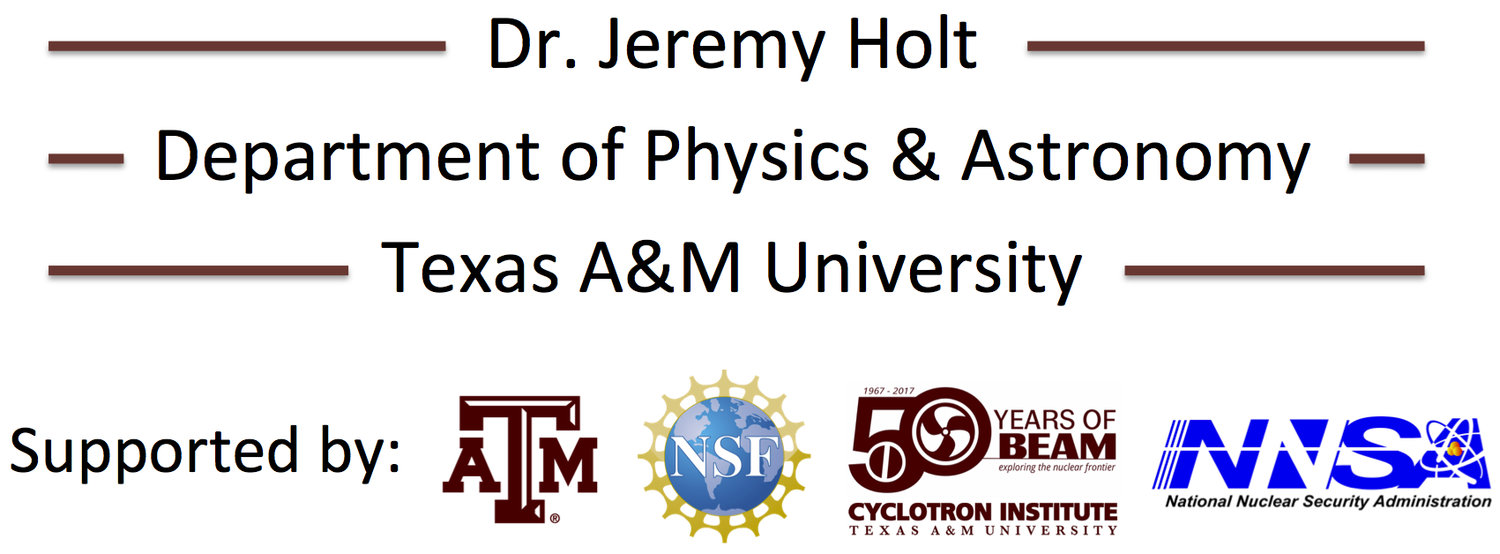Nuclear astrophysics from low-energy QCD
A major long-term goal is to understand how the strong nuclear force shapes the structure, evolution, and observable emissions of high-energy astrophysical systems, such as core-collapse supernovae, neutron stars, and neutron star mergers. To support this effort, I work to develop microscopic models of hot and dense neutron-rich matter based on the low-energy effective field theory of strong interactions.
Recent Publications
Tensor Fermi liquid parameters in nuclear matter from chiral effective field theory
J. W. Holt, N. Kaiser, and T. R. Whitehead, arXiv:1712.05013
Fermi liquid theory is widely used to describe the transport, response, and dynamical properties of nuclear and neutron matter in terms of interacting quasiparticles. In this paper we calculate for the first time the full decomposition of the quasiparticle interaction in symmetric nuclear matter into its central, relative tensor, center-of-mass tensor, and cross-vector interaction components. Realistic two- and three-body forces derived within the framework of chiral effective field theory are employed, and we estimate theoretical uncertainties by varying the resolution scale and order in the chiral expansion. In the figure to the right, we show the relative tensor Fermi liquid parameters as a function of the nuclear density.
Proton pairing in neutron stars from chiral effective field theory
Y. Lim and J. W. Holt, arXiv:1709.08793
Neutron superfluidity and proton superconductivity play an important role in the thermal evolution of neutron stars and the large-scale dynamical phenomenon of pulsar glitches. In this paper we study the 1S0 proton pairing gap ∆ as a function of density in beta-equilibrated neutron star matter within the BCS approximation starting from realistic two- and three-body chiral nuclear forces. We find that three-body forces suppress proton pairing and lead to a transition to the normal state at a density around twice that of saturated nuclear matter. In the figure to the left, we show the pairing gap as a function of the proton Fermi momentum in beta-equilibrium nuclear matter.
Nuclear dipole polarizability from mean-field modeling constrained by chiral effective field theory
Z. Zhang, Y. Lim, J. W. Holt, and C. M. Ko, Phys. Lett. B 777, 73 (2018)
The nuclear electric dipole polarizability has recently received much attention both theoretically and experimentally due to its strong correlation with neutron skin thicknesses, the density dependence of the nuclear symmetry energy, and the structure of neutron stars. In this paper we calculate the electric dipole response of medium-mass and heavy nuclei using a new energy density functional (Skχm*) fitted to the equation of state of neutron matter and nucleon effective masses in neutron-rich matter computed from chiral effective field theory. In the figure to the right, we compare our theoretical calculations for the isovector dipole transition strength function to experimental data on selected nuclei.
Structure of neutron star crusts from new Skyrme effective interactions constrained by chiral effective field theory
Y. Lim and J. W. Holt, Phys. Rev. C 95, 065805 (2017)
Detailed measurements of a pulsar’s spin frequency, spin-down rate, and average glitch spin-up rate can be used to estimate the ratio of the neutron star's crustal moment of inertia to its total moment of inertia. The crustal moment of inertia itself is strongly correlated with the crust-core transition density and pressure, which requires detailed microphysical modeling at the interface region. In this paper we construct new Skyrme effective interactions fitted to the neutron matter equation of state from chiral effective field theory to predict the crust-core transition density and pressure in the liquid drop model and Thomas-Fermi approximations. In the figure to the left, we show the pressure as a function of density for the different nuclear pasta regions that occur just before the transition to homogeneous nuclear matter in the neutron star core.





